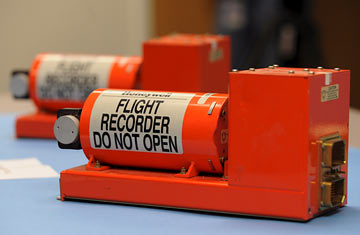
The flight-data recorder, front, and cockpit-voice recorder, back, of Continental Connection Flight 3407, which crashed near Buffalo, N.Y., on Feb. 12, 2009
When planes plummet from the sky, as a yemeni airliner did on its way to the Comoros Islands in the Indian Ocean June 30, the mysterious, indestructible gadget known as the black box is the best bet for pinpointing what went wrong. So when a French submarine detected the device's homing signal five days later, the discovery marked a huge step toward determining the cause of a tragedy in which 152 passengers perished.
In 1958, Australian scientist David Warren developed the first prototype for a black box, which became a requirement on all U.S. commercial flights by 1960. Early models often failed to withstand crashes, however, so in 1965 the device was given a design overhaul and moved to the rear of the plane--the area least susceptible to impact--from its original position in the landing wells. That same year, the Federal Aviation Authority required that the boxes, which were never actually black, be painted orange or yellow to aid visibility.
Modern airplanes have two black boxes: a cockpit voice recorder, which tracks pilots' commentary, and a flight-data recorder, which monitors fuel levels, engine noises and other operating functions that help investigators reconstruct the aircraft's final moments. Nestled in an insulated case and surrounded by quarter-inch panels of stainless steel, the boxes can withstand massive force and temperatures up to 2000°F. When submerged, they're also able to emit signals from depths of 20,000 ft. Experts believe the boxes from Air France Flight 447, which crashed near Brazil on June 1, are in water nearly that deep, but statistics say they're still likely to turn up. In the approximately 20 deep-sea crashes over the past 30 years, only one plane's black boxes were never recovered.
